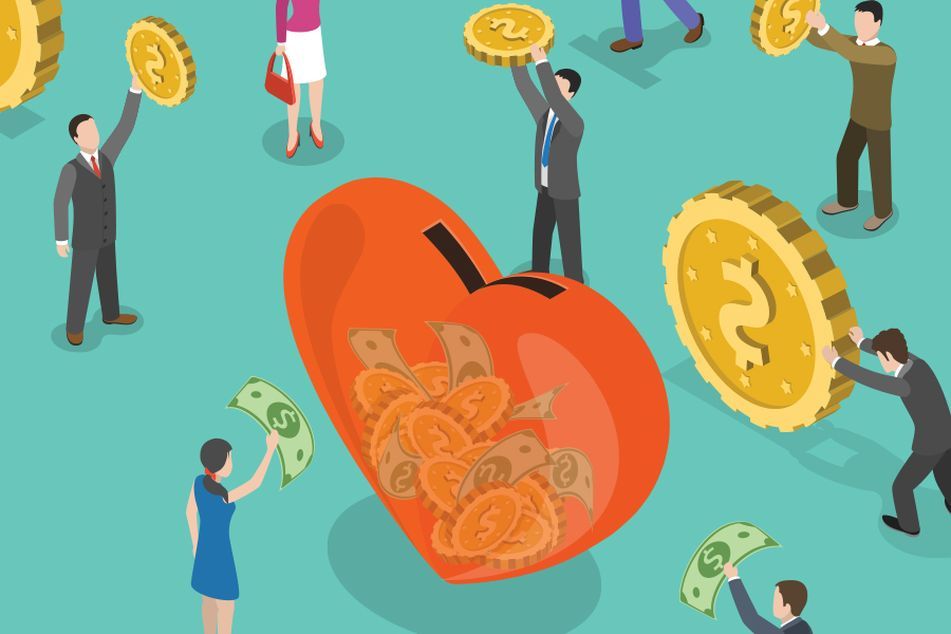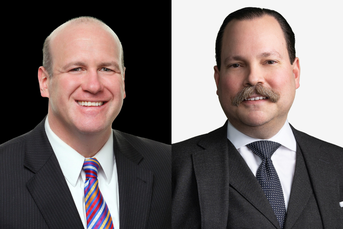Clients are upping charitable giving in the wake of the pandemic

Although the biggest reward of giving is psychological, the tax benefits can make doing good feel even better financially.
When investors’ portfolios do well, philanthropic organizations do well. Throw in a profound public health crisis and social unrest, and charitable giving hit new heights last year.
That philanthropic trend is likely to continue this year and combine with an uncertain tax outlook to provide opportunities for financial advisers to deepen client relationships by helping clients donate with financial efficiency.
Even as the pandemic roiled much of daily life last year, the stock market soared. The dynamic created a situation in which Americans became more inclined to contribute from the bounty of their investment accounts to help people who were struggling in their communities.
“There’s just an awareness today that didn’t exist prior to the pandemic,” said Roger Oprandi, managing director at Oprandi Wealth Group. “Clients have more money, their accounts have grown, their businesses are doing well, so they’re more generous.”
Americans gave a record $471 billion to charity in 2020, a 3.8% increase from 2019, according to the Giving USA report released in June. Even though the economy struggled, the strong market bolstered philanthropy, said Una Osili, associate dean of the Lilly Family School of Philanthropy at Indiana University-Purdue University Indianapolis, which conducted the study.
“That created greater opportunities for people to make charitable contributions, especially in the latter part of the year,” Osili said.
Similar numbers were reported by the major sponsors of donor-advised funds. Fidelity Charitable donors recommended 2 million grants that totaled $9.1 billion to 170,000 charities, a 31% increase in grants and 24% in increase in dollars over 2019. Schwab Charitable donors gave $3.7 billion in grants, a 35% increase, to 100,000 charities.
The confluence of altruism and market gains was unique, said Leon LaBrecque, chief growth officer at Sequoia Financial Group.
After the Sept. 11, 2001, terrorist attacks in New York, Washington and Pennsylvania, there was strong philanthropic sentiment “but we didn’t have the same kind of market,” LaBrecque said. Today “there’s a wealth effect. People are saying, ‘I’ve done well, and I’m going to share the wealth.’”
AN UPWARD TRAJECTORY
One reason enthusiasm for giving is strong is that donors are seeing the local impact of their philanthropy. Vanguard Charitable reported that donors granted more than $69 million to homeless shelters and food pantries in 2020, a 147% increase from 2019.
Barbara Tarmy, a partner at Williams Jones Wealth Management, said her clients gave to organizations that provided housing and food and supported the arts.
“They can see the positive effects of giving,” Tarmy said. “Everyone who had been giving became meaningfully more generous.”
As the country emerges from the pandemic, many advisers say the upward trajectory of charitable giving will continue. There are plenty of worthy causes, such as racial justice and voting rights. Some unemployed people and parts of the economy continue to struggle, while the stock market climbs.
“We have definitely seen our donors commit to giving — even more so than last year,” said Kristen Robinson, chief operating officer at Fidelity Charitable.
Fred Kaynor, vice president of business development and marketing at Schwab Charitable, noticed a similar trend.
“We’re seeing a sustained level of generosity from our donors that started at the height of the pandemic,” Kaynor said. “It appears they’re going to continue their charitable contributions and expand the number of charities they support.”
Joanne Burke said her clients will maintain their heightened level of giving because the strong market is allowing them to take care of other priorities, such as saving for retirement.
“I feel as if they’re going to continue [charitable giving] into 2021 and beyond,” said Burke, owner of Birch Street Financial Advisors. “Even with giving, they feel they’ll have enough to live the life they want to live. They’re still confident.”
Another trend that began in 2020 and is continuing into this year is the growing number of sales of small businesses, which leave their former owners in a good position to pursue philanthropy, said Kevin Donohue, a partner at Legacy Planning.
“That’s got to be at an all-time high,” Donohue said. “That lends itself to significant charitable contributions being made.”
Often a client develops a philanthropic habit through a qualified charitable distribution from an individual retirement account. Investors who are 72 or older who have to withdraw money from IRAs can make a charitable contribution of up to $100,000 and not have it count toward their adjusted gross income.
This philanthropic strategy also has been boosted by the strong market, which has created supple IRAs.
“What we’ve seen more of this year is direct gifting of RMDs from clients’ IRAs,” said Christopher Conigliaro, president of Seasons of Advice Wealth Management. “IRA account values are higher than I’ve ever seen in my career.”
‘CASH IS FOR AMATEURS’
Although the biggest reward of charitable giving is psychological, the tax benefits can make doing good feel even better financially. Advisers can help by ensuring that clients’ donations are tax efficient, and often accomplish that goal by using donor-advised funds.
The vehicles are becoming a popular way to execute philanthropy. More than $25 billion in grants to charitable organizations were made from DAFs in 2019, a 93% increase over 2015, according to the National Philanthropic Trust. Contributions to DAFs totaled $38.31 billion in 2019, up 80% since 2015.
With a DAF, clients can make a donation of highly appreciated stock or other assets — often bundling the equivalent of several years of charitable giving — and immediately receive a tax deduction. They can then leave the money in the account for years, while they decide how to allocate it to charity.
Financial advisers say a recurring mistake they see in charitable giving is when people sell stock to make cash gifts, thus incurring a capital gains tax that also decreases the amount of money that goes to a charity. If stock is put directly into a DAF, the donor avoids capital gains taxes.
“Cash is for amateurs,” said Darin Shebesta, vice president of Jackson/Roskelley Wealth Advisors. “Your DAF is like your own 501(c)(3). You don’t need to be a Jeff Bezos or a Mark Zuckerberg or an Elon Musk to be a philanthropist.”
Although the use of DAFs is soaring, the accounts aren’t necessarily household names for investors.
“The vast majority of new clients coming to us have never heard of DAFs,” said Bruce Weininger, a principal at Kovitz Investment Group. “It’s one of the first things we talk to clients about.”
When clients put stocks or cash into a DAF, the assets leave their investment account and might also leave the control of their adviser. The donor can make recommendations on how to allocate the assets but the transaction is controlled by the DAF sponsor, such as Fidelity Charitable or Schwab Charitable.
But if the DAF has enough assets — usually $250,000 or more — sponsors let the donor’s adviser go on managing the account. It’s a way for advisers to continue overseeing the breadth of the client’s finances.
“For high-net-worth donors, they want their advisers to manage all assets in the portfolio,” Fidelity Charitable’s Robinson said. “It’s definitely a growth area for us.”
Advisers and their clients are likely going to continue turning to DAFs as Congress considers tax hikes on the wealthy. Potential higher taxes on ordinary income and capital gains have spurred Roth conversions and capital gains harvesting coupled with a charitable gift to a DAF, said Larry Harris, director of tax services at Parsec Financial.
“The combination of these factors served to make 2020 a strong year for DAF giving,” Harris wrote in an email. “The strength of the market and continued concerns about higher tax rates will be the deciding factors driving the level of DAF giving in 2021.”
TAX HIKES
The trajectory and methods of charitable giving this year could be affected by tax increases, if they come to fruition. For instance, as part of its capital gains tax hike proposal, the Biden administration would end the so-called step-up basis and tax capital gains of more than $1 million on inherited assets.
“If you’re not going to get that step-up basis, then using appreciated assets to fund your charitable giving is an even better strategy,” Weininger said.
It’s not just looming tax increases that are affecting charitable giving, but also the pending loss of tax breaks that will sunset after 2025 under the 2017 tax reform law. That situation is making qualified charitable distributions from IRAs more important, said Jordan Benold, owner of Benold Financial Planning.
“I have been educating [clients] that tax rates … will probably not be this low again,” Benold wrote in an email. “Thus, using the QCD will significantly lower their taxable income in later years when their RMDs increase.”
Marianela Collado, chief executive of Tobias Financial Advisors, is warning her clients that the so-called “Pease limitation” on itemized deductions that was eliminated under the 2017 law is due to return in 2026.
“We have a small window where these high-net-worth individuals will be able to give a massive amount and not be subject to phase out of their itemized deductions,” Collado said. “We’ll see charitable contributions continue to be significant until the Pease limitations are back in effect in 2026.”
Last year, the pandemic and a surging market were the surprise factors that boosted charitable giving. This year, the pandemic challenges linger, the market remains strong and now potential tax increases are adding fuel to philanthropy.
“There’s going to be a larger resurgence of charitable giving, particularly in appreciated assets” if step-up basis ends, LaBrecque said. “It will probably be off the charts.”
Learn more about reprints and licensing for this article.








